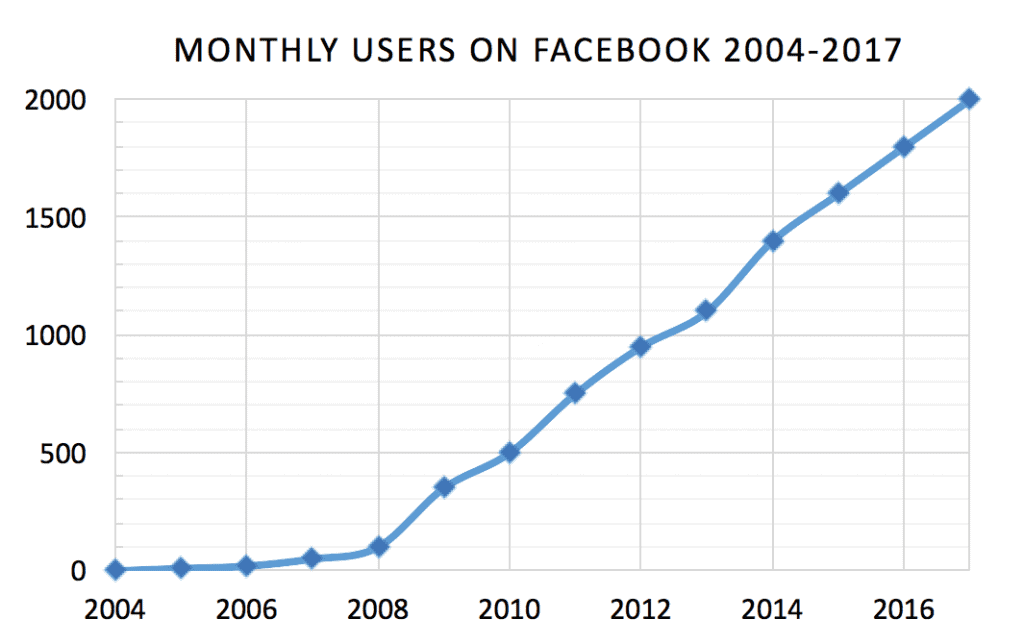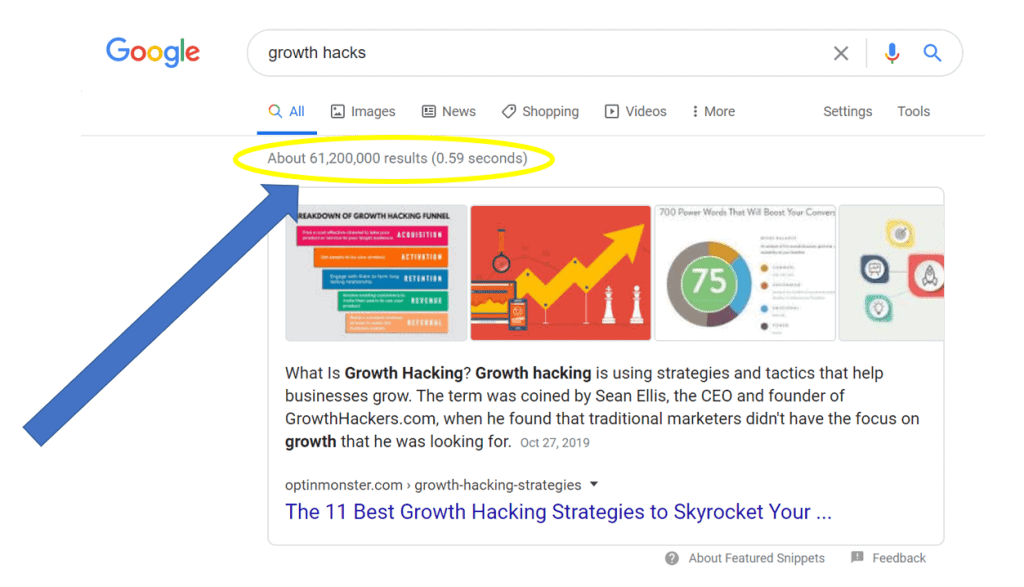Growth hacking has been all the buzz in the startup world ever since the term was coined by Sean Ellis.
Growth hacking is using certain techniques to be able to create rapid growth in site visits, sales, customer sign-ups, etc.
The word hack, however, gives a misconception that there is a simple and quick trick that will instantly spark massive expansion for your company.
And on a surface level, it looks like that.

Photo credit: Wikimedia Commons
Facebook is known for its growth hack of using MySpace to help launch its success. This graph makes it look like all it took was that one trick and BOOM! Off it went to becoming a company with 1.73 billion daily users.
1.73 billion.
But what this graph doesn’t show, is everything that went before Facebook’s rapid user growth.
The graph doesn’t show all of the work, ideas and trial and error that led to finding a system that worked for Facebook.
So the question becomes, how do you do what Facebook did?
Sure, you can go and start Googling a bunch of growth hacks and find millions of results.

61,200,000 to be exact.
But you’re not going to find the magic secret that will instantly grow your customer base. Because if there was one, everybody would be doing it.
And you wouldn’t be reading this blog right now.
So, before you start combing through Google’s endless search results (don’t worry, you will eventually), let’s talk about how you can streamline the process by creating a growth hacking framework.
Why Create a Growth Hacking Framework?
The Puzzle Analogy
Let’s say you were about to do a puzzle. Would you just start by randomly trying to fit pieces together?

Photo Credit: UI Here
Of course not!
First, you find the corner and edge pieces; then you group them together by color, then you look for pieces that look like they’ll match.
In other words, you have a system or framework.
It’s the same with growth hacking. Randomly trying different growth hacking tactics is a waste of time.
But if you have a growth hacking framework in place, you save time and resources.
Having a process will also benefit you in the long term, because it is repeatable and scalable, meaning you can go back to it when you need it.
Crafting the Perfect Growth Hacks
A growth framework also helps you craft strategies that will fit your business.
Because every tactic won’t work for every business, and your product is unique, so your growth hacking should be too.
It does this by allowing you to pick growth hacks that will help you achieve your goals. You get to see what does and doesn’t work, then adjust, replace, or make new techniques as needed.
Trust The Process
Just like the Philadelphia Seventy-Sixers basketball team, having a process, you can lean on when you’re struggling can be reassuring.
Don’t mistake this for blindly following something that isn’t functioning or that you don’t have to do any work.
But when things are looking slow or bleak, it is helpful to know you have a framework to fall back on to try new things, adjust, even start over if you need to.
Without one, you may not know what to do next, and it will feel like you are walking through fog.
Creating Your Growth Hack Framework
Step 1: Research
If you’re reading this, you’re likely in the process of this already.
But keep going!
It’s important to know what is out there.
Find companies that are similar to yours and see
- What kind of frameworks already exist
- Which frameworks have worked well
- Which ones haven’t worked well
Of course, your product will be different from other businesses, so you shouldn’t just copy what they do.
But doing some research will give you a solid starting point.
Step 2: Define your goals
Goal setting is super important if you want to accomplish anything in life, and the same goes for your business.
It gives you and your employees something to strive for and can be a powerful motivator.
When defining your goals, however, it is best to make them tangible and include some that are unreasonable but possible.
Tangible
Tangible goals are helpful because it gives you something concrete you can do and accomplish.
Yes, your goal is to expand your customer base. But by how much? And how do you plan on doing it?
So instead of saying:
“I want more customers.”
Try:
“I am going to sign on ten clients by the end of the month.”
Having a goal like this makes it easier to figure out the proper tactics you should use to achieve your goal.
“In order to sign ten new clients, I am going to send ten emails a day to potential clients.”
Unreasonable But Possible
If you set goals you know you can achieve, it’s easy to get complacent and stifle your company’s growth.
Setting impossible goals can again, stifle growth because you know you won’t hit them, causing you not to try as hard.
But an unreasonable but possible goal is the Goldilocks of goals. The ambition that comes from a goal that is just out of reach but also possible will cause you to push harder.
Even if you don’t meet your goal, you likely will have achieved more than if you set a more complacent goal.
A popular framework for goal setting is called “Objectives and Key Results” (OKR), which is used by companies like Google, LinkedIn, Spotify and Twitter.
It involves creating:
- Objectives: memorable qualitative descriptions of what you want to achieve.
- Key Results: sets of metrics that measure your progress towards the objective.
Step 3: Analyze and Think
Now that you have your goals laid out, it’s time to analyze them and brainstorm solutions, strategies and ways to achieve them.
Get yourself a word doc, a yellow legal pad, a whiteboard, or whatever, and write down any idea you can think of.

Photo Credit: Wallpaper Flare
Even the bad ones. Because you never know when a bad idea can lead to or inspire a good one.
Or maybe you’ll even find that the bad idea is better than you thought later down the road. Now isn’t the time to get nit-picky. You’ll be able to narrow down your ideas later.
Do this with your other co-workers and employees. Brainstorming is often an external process, so it is helpful to have other people to toss around and develop ideas together.
It will also help to do some more research.
Similar to step 1, seeing what growth hacking tactics have and haven’t worked for similar businesses.
Remember, your product is unique; your growth hacks will be as well. But this research will serve as a great starting point to inspire creative solutions.
Which is what the next step is all about.
Step 4: Get Creative With Your Growth Hacks
Start going through your research and brainstorming, and start picking out some of your best ones.
Mould them and make them unique to your product. And don’t be afraid to come up with brand new and innovative ideas. This is the time to have fun and be creative!
Someone came up with all these other standard growth hacks like blogs, newsletters and reward programs. So why can’t you come up with the next big growth hacker?
Things to think about during this process are:
- How can I make this strategy align with my product organically?
- What aspects of these growth hacks have worked for products similar to mine? Which aspects haven’t worked?
- What is something original I can add to this?
From there, take some of what you think are your best ideas and move on to the next step.
In doing so, ask yourself:
- What is the likelihood this will work?
- Is this tactic feasible? Do we have the resources for it?
- How will this help grow my customer base?
Step 5: Bring Out Your Inner Scientist And Test Your Strategies
Testing is key. Because no matter how much you think something will work, there is no way to know without doing it.
Do you think everyone took Albert Einstein’s word that E=mc^2? Nah, he tested that bad boy.
And the same goes for your growth hack project.
So go back to your school science fair days, draft up a hypothesis, and implement your strategy to see if it works.
Doing so for a period of one to three months is ideal, as it is long enough to give you a solid sample size, but short enough where you won’t be wasting time or negatively impacting your business.
Along the way, be sure to document, document document!
Gather as much data, statistics, customer and employee feedback and other information as possible.
Next, you’ll take your results and analyze them to determine if your hypothesis was correct, and whether or not your growth hack was effective enough to implement long term.
Be sure to ask:
- Were they effective?
- How were they effective?
- Why did they work the way they did?
- Were your predictions accurate?
Then one of two things will happen.
Step 6a: Implement Permanently!
If your growth hack works, then use it permanently! That’s what this was all about right? Finding the growth hack that is best for your business.
Be sure to document your process to create a repeatable and scalable growth hack framework or playbook that you can go back to when needed.
For example, Uber has a playbook when launching in a new city and for growing its app’s user base.
You can even give it a cool name like The Philly Special or Spider 2 Y Banana.
If you determined that your strategies were ineffective, however, that’s totally ok! Failure is part of the process. The important thing is that you learn from it.
If you find yourself in this situation, go to…
Step 6b: Assess and Adjust
Take a step back and figure out what went wrong.
- Why did it go wrong?
- Is it something that can be adjusted?
- Or should this strategy be eliminated completely?
Then, go back and make adjustments as needed or start over with a new tactic. Or maybe you need to combine some tactics and mix and match until you find the right combination.
Just keep trying, and keep testing until you find what growth hack(s) work best for you and your product.
It may take several tries, but that’s part of the process of making your growth hack framework!
For more help
Check out these Growth Hack Tactics That Every Startup Needs To Know. Or, talk to Pearl Lemon Convert’s experts who can help you create your growth hack framework today!








